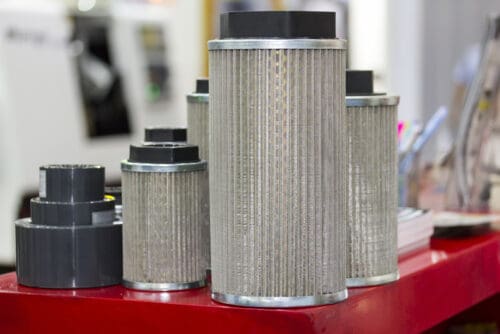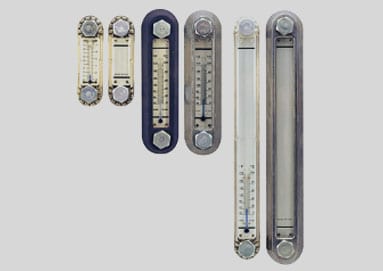How do I know when to change a hydraulic filter?
Leave a Comment
Staying up-to-date with proper filter changes can save big headaches in the long run by preventing equipment downtime, decreased performance, and lost revenue. We’ll walk you through how to know when it’s time for a new hydraulic filter so you can ensure reliability and efficiency across your operations.
What Happens During Contamination in Hydraulic Filters
Particle contamination is one common concern in a hydraulic oil filter. These can cause clogs, leading to pressure drop across the system since fluids can’t pass freely. In these cases, the results may be devastating. If the system has a bypass valve, the fluid will pass through once the pressure reaches critical levels, and unfiltered fluid will pass unhindered.
Alternatively, the contaminants will continue to pass because the clogged filter causes the pressure drop to increase until it collapses. Now, the contaminants have infiltrated both the system and the filter itself. If the filter doesn’t collapse and the pressure levels rise too high, it can still cause damage to the system’s internal parts and components.
Importance of the Right Filter Size
Choosing the right hydraulic oil filter size matters to get the most out of your hydraulic system. The filter must be appropriately sized to keep the pressure drop compatible with the contaminated fluid passing through. The right size also helps you determine the dirt-holding capacity of the system to avoid changing the filters too early or too late.
Here are some considerations:
- Pump’s flow rate
- Pipe size
- Working system pressure
- Type of hydraulic fluid
- Fluid’s viscosity
- Type of pump being used
- Filtration level
- Type of filter required
- System’s operation
- System’s operating temperature
With these considerations, you can choose a suitable filter size that can withstand contaminants while keeping you on track as you follow your maintenance schedule. It ensures your entire subsystem is protected while it operates seamlessly.
Establish a Routine Maintenance
It’s economical to have routine maintenance when it comes to changing the filter of your hydraulic system. A schedule will prevent unexpected failures leading to downtimes and costly replacements or repairs. Filters should be changed when the capacity is at 80% before it reaches its bypass stage.
With that said, there are three filter locations to remember for optimal performance:
- Off-line filtration: Offer flexibility in placement and provide continuous filtration.
- Return filtration: Protects against contaminants when the fluid returns to the tank. It’s an economical way of maintaining cleanliness.
- Pressure filtration: Safeguards components downstream when filtering particles from a high-pressure hydraulic filter.
Your system’s hydraulic filters require preventative maintenance as it will ensure that it runs with better efficiency at all times. It will solve any clogged filter problems before it begins, maintaining cleanliness and preventing significant damage. Ultimately, it can help you save money and time in the long run.
Prevent Contaminants with the Right Filter & Following Your Scheduled Maintenance
Implementing a maintenance schedule will make it easier for you to maintain the upkeep of your system while avoiding unnecessary costs due to unexpected damage. Remember always to use the correct type of filter for your system and make sure it’s appropriately sized.
If you’re looking for hydraulic filters and cylinders, don’t hesitate to contact us today. Request a quote, and our team at DOMS Incorporated will help you find the best product for your hydraulic system.
What does a hydraulic pressure gauge do?
Leave a Comment
This versatile device makes it possible to easily track and document changes in fluid pressure so you can respond swiftly to changing situations and keep your operations running smoothly.
But what exactly does this remarkable piece of equipment do?
We’ll explore the purpose of the hydraulic pressure gauge and take an in-depth look at how it works. Read on if you’re ready to understand how this tool can effectively monitor and control pressure levels in your environment!
What is a Hydraulic Pressure Gauge?
A hydraulic system’s pressure gauge measures the pressure within the system and displays it for operators to see. Generally, the display is connected to a sensor to measure the system’s fluid intensity pressure. It helps determine if the system is operating safely and within accurate parameters.
With pressure gauges, the fluid power systems become predictable and reliable. Without it, there’s no way to know if the pressure is too high or too low, leaving it open to potential system impairment. Having this dependable device can prevent leaks or if there’s contamination in the system that needs to be addressed.
Main Reasons to Use a Pressure Gauge for Hydraulic Systems
Be aware of what might happen in your hydraulic systems while increasing safety with these measurement devices. Rely on it for predictability while achieving robust system performance. At the same time, avoid future risks and system failures.
Other reasons to use a hydraulic pressure gauge:
- Easy troubleshooting: Gauges tell if there’s a problem elsewhere if pressure isn’t the problem.
- Enhanced visibility: It tells you when it’s safe to carry out investigative activities.
- Spot and avoid leaks or damages: Leaks or blockages can reduce the pressure in the system, which will appear on the gauge.
- Avoid potential hazards: Hazards are prevented when using the correct gauge, such as explosions, injuries, or leaks.
- Peace of mind and reassurance: You have extra reassurance, knowing you have an accurate and reliable monitoring tool to gauge the system’s pressure.
Why Use a Liquid-Filled Pressure Gauge?
Hydraulic pressure gauges contain liquid, such as glycerin, silicon, or mineral oil. These dampen the movement of the gauge’s internal components. It’s commonly found in most on-site commercial and industrial applications due to the benefits it provides, including:
- Higher accuracy: These are less affected by vibration and improve the gauge’s accuracy because the liquid absorbs the pressure fluctuations by dampening movements.
- Less affected by temperature changes: The liquid insulates the system’s components from temperature changes, preventing thermal expansion or contraction.
- Durability: Liquid-filled gauges are more durable than other types because they protect the gauges’ internal components from corrosion and wear. It also prevents dirt, dust, and other contaminants from entering the system, improving its performance and lifespan.
- Reduce pressure spikes: While the pressure rises, the liquid compresses and absorbs the spikes to prevent damage to the internal components.
Other Key Considerations When Choosing a Hydraulic Pressure Gauge
Apart from liquid-filled gauges, learning some essential considerations will help you determine the best pressure gauge for your system. Some things to remember include:
- Pressure range needed
- Pressure and force
- Scale, digital, or dry gauges
- Choice of material
- Mounting options
- Right thread on the mount
- Accessories for superior performance and accessibility
Use a Pressure Gauge for Better Hydraulic Operations
For a safer and more seamless operation in your facility, equip your hydraulic systems with the proper pressure gauge from DOMS Incorporated. Don’t hesitate to contact us today, and we’ll develop a pressure gauge device according to your project’s needs and requirements. Request a quote, and we’ll work on a cost-effective solution together.



